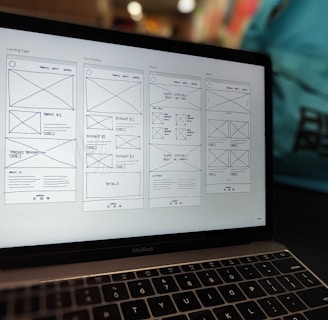How to Use Nudge Theory to Improve User Experience (UX)
Blog post description. Have you ever wondered why some websites and apps seem to get you? You effortlessly find what you're looking for...
Ariyan Ali
1/8/20256 min read


What Is Nudge Theory?
Nudge Theory, introduced by Richard H. Thaler and Cass R. Sunstein in their book Nudge: Improving Decisions About Health, Wealth, and Happiness, is all about influencing people's choices in subtle ways. It’s not about forcing anyone to do anything—it’s about making the right choices easier and more attractive.
One of my favorite quotes from the book says: "A nudge is any aspect of the choice architecture that alters people's behavior predictably without forbidding any options or significantly changing their economic incentives."
Think of it like a gentle tap on the shoulder, reminding someone to make a good decision—but it’s still their choice to follow through
How Does Nudge Theory Work in UX?
Let’s imagine you’re designing a website or an app. You want users to complete tasks like signing up for a newsletter, making a purchase, or filling out a form. Using Nudge Theory, you can gently guide them toward those actions. Here’s how it can play out in real-life scenarios.
1. Making Defaults Work for You
People tend to stick with what’s given to them by default. So, if you want users to opt into something—like receiving updates or saving their preferences—make it the default option.
For example, think about when you sign up for a streaming service, and it automatically saves your login info for the next time. You can turn it off, but most people don’t bother because the default setting is already convenient. Another example: imagine you’re signing up for a subscription box, and the system defaults to the most popular plan. This nudge makes users feel like they’re making a safe, smart choice without overthinking it.
2. Gentle Reminders and Friendly Notifications
Let’s face it—life gets busy, and people forget. A well-timed nudge, like a friendly reminder, can bring users back on track.
Take shopping carts in online stores, for example. How many times have you added items to your cart and walked away, only to get an email saying: "Hey! You left something behind. Complete your order now, and we’ll give you 10% off!"
This isn’t just a sales tactic; it’s a nudge designed to gently push you to take the next step. Or think about fitness apps that send you notifications like: "You’re only 1,000 steps away from hitting today’s goal—keep going!"
These small nudges can motivate users without feeling pushy.
3. Social Proof: Everyone’s Doing It
People often look to others for guidance, especially when they’re unsure about what to do. This is why showing how popular something is can nudge users in the right direction.
For example, when you visit a product page and see a note saying: "This item is a bestseller with over 5,000 happy customers!" You’re more likely to think, “Well, if so many people love it, it must be good!” Or on Netflix, when a show is labelled “#1 in your country today”, you might be tempted to check it out—even if you weren’t planning to.
4. Small Changes, Big Impacts
Sometimes, the tiniest changes in design can nudge users without them even realizing it. A simple example? The color and placement of a button. Imagine you’re designing a sign-up form. By making the “Sign Up” button bright green and placing it front and center, you subtly encourage users to click it. If the button were gray and hidden at the bottom, it might get overlooked.
Another example is using progress bars. Let’s say a user is filling out a long form. Showing a progress bar that says, “You’re 80% done!” can nudge them to complete it because they feel like they’re so close to finishing.
5. Framing Choices Positively
The way you present information can have a huge impact on what users choose. This is called framing in Nudge Theory.
For example, imagine you’re comparing two subscription plans:
Plan A: $10 per month
Plan B: Save 20%—only $8 per month!
Both are technically the same, but Plan B feels more appealing because it highlights the savings. It’s a nudge that makes the decision easier for users. Similarly, apps and websites often use phrases like: "Join 1,000+ happy members today!" It’s a small tweak, but it makes users feel like they’re part of something bigger.
6. Scarcity and Urgency: Act Now!
People hate missing out. By creating a sense of urgency or scarcity, you can nudge users to act quickly.
For instance, think about booking a hotel room online. Have you ever seen a message like:
"Only 2 rooms left at this price!"
It’s a nudge that makes you feel like you need to act fast or risk losing the deal.
This works for sales, too. An online store might show a countdown timer for a flash sale, nudging users to make a purchase before time runs out.
7. Helping Users Make Informed Decisions
Sometimes, nudges are about giving users the right information at the right time. For example:
Showing reviews and ratings on product pages helps users feel confident in their choices.
Offering comparison charts for different plans or products makes decision-making easier.
In the words of Thaler:
"If you want to encourage people to do something, make it easy."


Why Does Nudge Theory Work in UX?
What makes the Nudge Theory so powerful is its simplicity. You’re not forcing users to do anything; you’re just making the desired action more natural and intuitive. This approach respects the user’s freedom while still guiding them toward better decisions.
And the best part? Nudges can improve not just conversions and sales but also user satisfaction. When users feel like they’ve made a smart, informed choice, they’re more likely to return.
A Quick Word of Caution
While nudges are incredibly effective, it’s important to use them ethically. Always ask yourself:
Am I helping the user or just manipulating them?
Is the nudge making their experience genuinely better?
When done right, nudges can build trust and long-term loyalty.
Wrapping It Up
At its core, Nudge Theory is about understanding human behavior and designing experiences that align with it. Whether it’s through default settings, reminders, or social proof, the goal is to create a seamless and enjoyable journey for your users.
As Richard H. Thaler said: "Small nudges can make a big difference." So next time you’re working on a website or app, think about the little changes you can make to gently guide users in the right direction. Because sometimes, all it takes is a little nudge to turn a good experience into a great one. By embracing the Nudge Theory, you can create user experiences that are not only effective but also thoughtful and user-friendly. Give it a try—it might just transform the way people interact with your designs!


Frequently Asked Questions:
1. What is the Nudge Theory in UX design?
Nudge Theory is a concept from behavioral economics used in UX to influence user behavior through subtle design changes. It helps guide users toward better decisions without forcing them by making actions simpler, more intuitive, or more attractive.
2. How does Nudge Theory improve user experience?
Nudge Theory improves user experience by reducing friction, providing helpful guidance, and encouraging desired actions. Examples include default settings, progress bars, or notifications that remind users to complete tasks—all of which make interactions smoother and more satisfying.
3. What are some examples of nudges in websites and apps?
Default options: Automatically opting users into settings like email updates.
Social proof: Showing how many people have purchased a product or signed up for a service.
Scarcity or urgency: Messages like "Only 2 left in stock" or countdown timers for sales.
Progress indicators: Displaying how much of a process is completed to encourage users to finish it.
4. Is using nudges ethical in UX design?
Yes, when used responsibly. Ethical nudges help users make better decisions and improve their experience without manipulation. Always prioritize transparency and user benefit. Avoid dark patterns—design tactics that trick users into unintended actions.
5. How can I start applying Nudge Theory to my designs?
To use the Nudge Theory effectively, observe where users drop off or hesitate in your interface. Implement small changes like clearer call-to-action buttons, helpful reminders, or simplified choices. Test different designs to see which nudges lead to better user engagement and satisfaction.
Have you ever wondered why some websites and apps just seem to get you? You effortlessly find what you're looking for, feel encouraged to take action and leave feeling satisfied. Chances are, those websites and apps are using a concept called Nudge Theory, a brilliant idea from behavioral economics that can transform how people make decisions.
